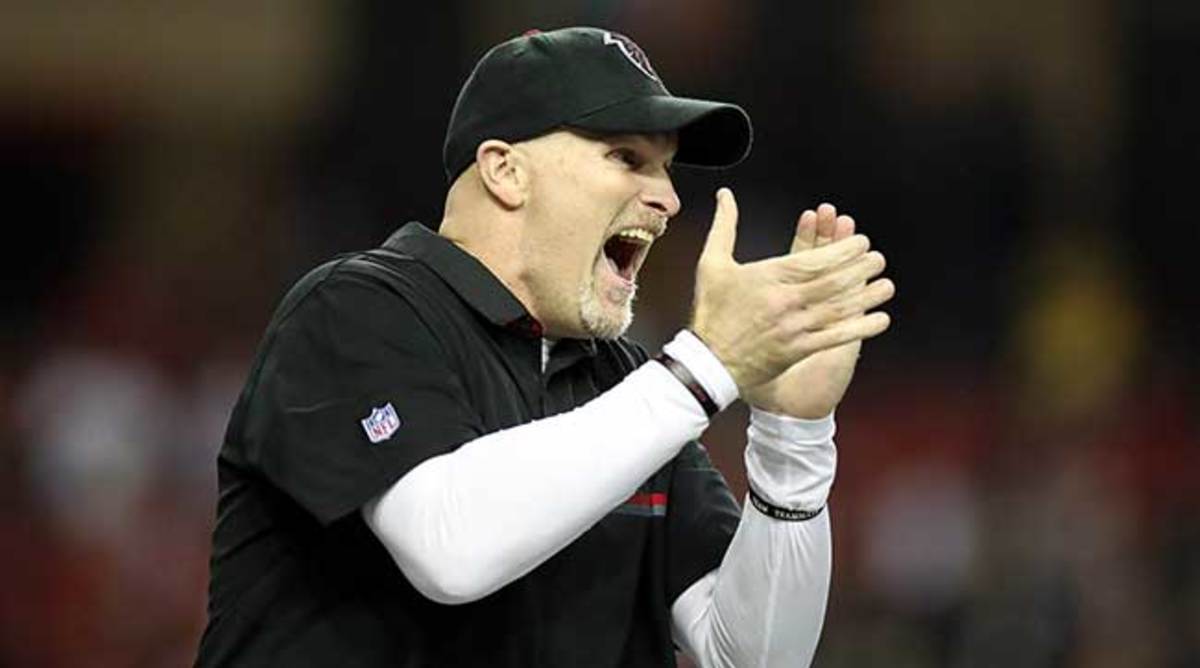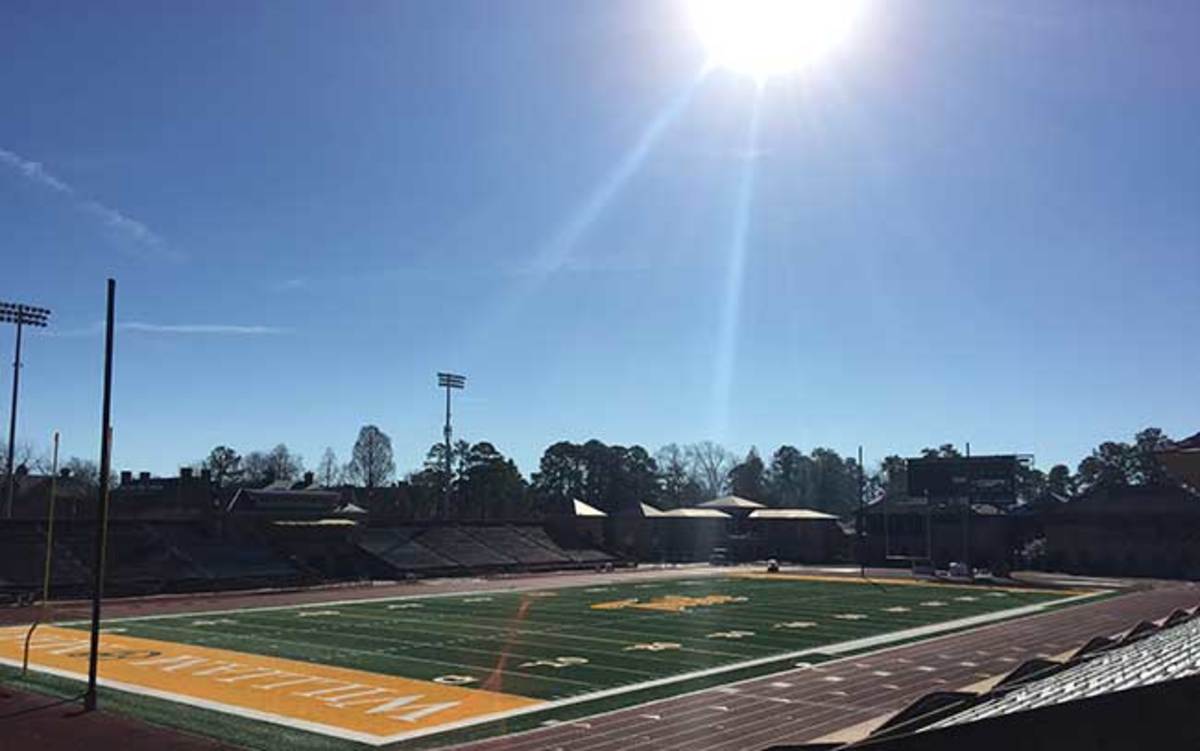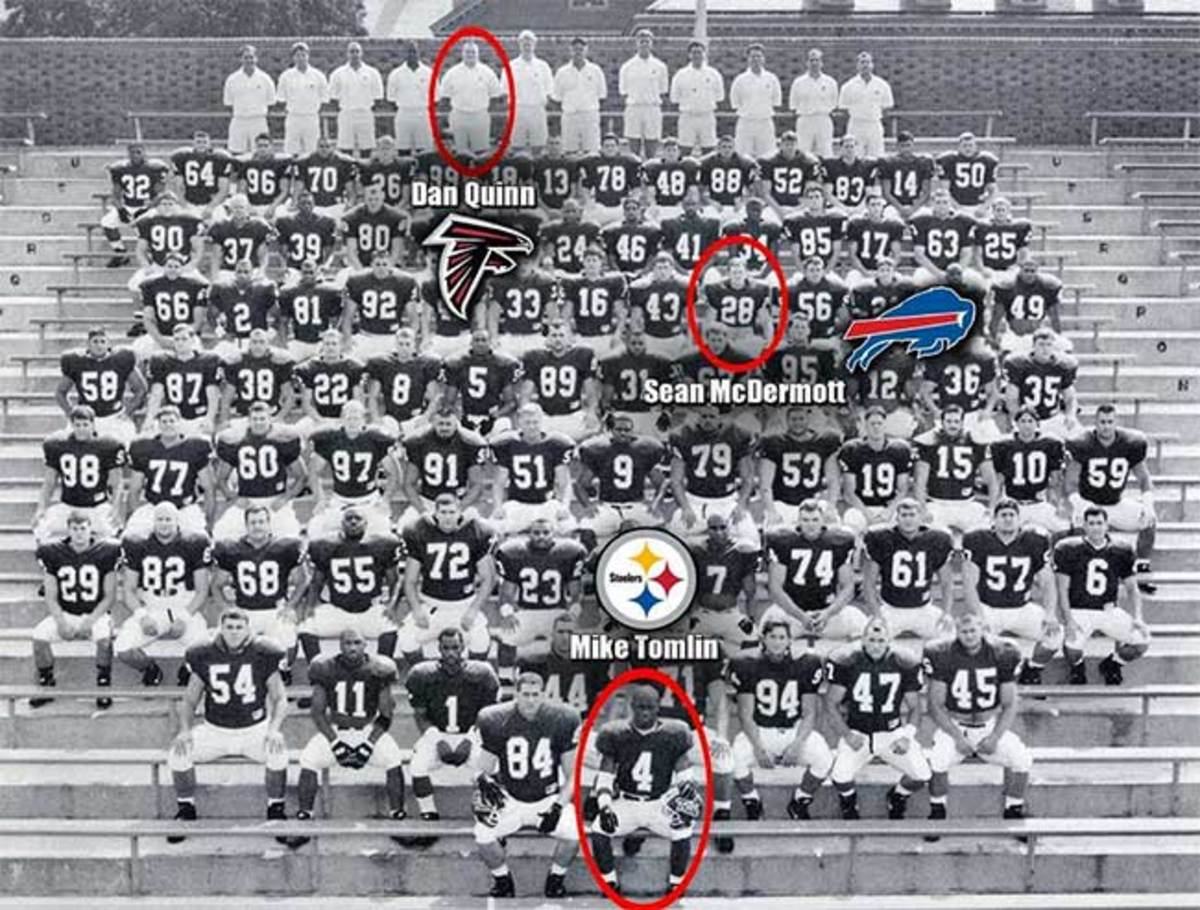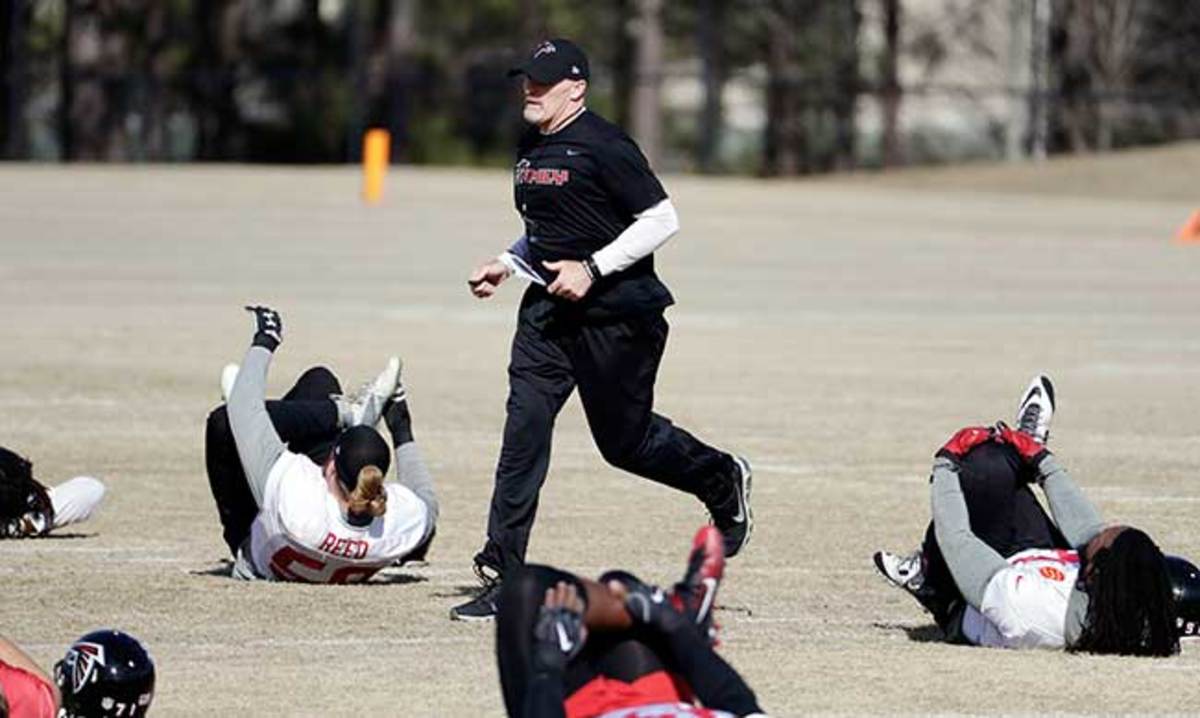Dan Quinn: From William & Mary to the Super Bowl

The MMQB is on the road to Super Bowl 51. Follow along on Twitter, Facebook, Instagram and Snapchat (@TheMMQB), and find all of our #RoadtoHouston content here.
WILLIAMSBURG, Va. — In the fall of 1994, most nights of the week you could find Jason Miller at the Green Leafe Café here, across the street from the William & Mary football stadium. Miller was a senior linebacker on the team, but he’d blown out his knee in the first game, and he wanted to drink his sorrows away. The Green Leafe was the bar where students usually hung out. It had sticky floors and cheap drinks, chipped paint and wooden booths.
“It was a great place to just get ripped,” Miller says.
Sometimes Dan Quinn would meet Miller at the Green Leafe. Quinn was 24 years old, fresh out of college, and working part time as the William & Mary assistant defensive line coach. He was putting in 60-hour weeks for about $10,000 a year. He’d slide into a back booth with Miller and Len Annetta, another assistant coach he knew from college, and they’d talk football, life and the grind of it all. Then the bill would come.
“Sometimes I picked up the tab,” says Miller, “because he couldn’t afford to.”

Quinn can afford to buy the entire bar a round now; in two Sundays he’ll be leading the Falcons into the Super Bowl. But here was where his coaching career started, at a Division I-AA (now FCS) school, working late hours, watching film, running errands and setting up cones for drills. He was so low on the totem pole that he didn’t even have his own position group. He coached the defensive tackles, and didn’t have an office.
Jimmye Laycock, the head football coach, laughs at the memory. He’s been the head guy for 37 years here, the longest active streak of any Division I or FCS football coach. He played quarterback here for Marv Levy and then Lou Holtz, in what was Holtz’s first head-coaching gig. No office? When Laycock took over in the ’80s, coaches had it worse. The team usually practiced on the outfield of the school’s baseball field so not to tear up the grass on the stadium field. In the spring, when the baseball team reclaimed its field, football had to practice on an empty plot of nearby land next to an insane asylum. The patients would often wander over and walk through drills. “When I’d hire a new coach, I’d never tell him,” Laycock says, letting out another laugh. “I’d just tell him there were some interested alums coming by practice.”
• MATT RYAN IS OLD SCHOOL: At venerable Penn Charter, the Falcons QB is remembered as a low-key leader, and a 6'5" triple-option threat
Laycock was tough on his assistants, especially the young ones. He was a stickler for details and short on patience. Years ago he used to handle his players’ away-game ticket requests, so it’d be done the proper way. In time he delegated more to his assistants, but only the ones he trusted. You knew where you stood with Coach based on how much he spoke to you, how much work he gave you. The busier you were, the more Laycock trusted you. If you spoke up during a staff meeting, it had better be worthwhile, or else Laycock would let you know. “I’m not one to have meetings just to have meetings,” Laycock says. “I’m not interested in a whole lot of frivolous talk. Let’s get to the point. Say something meaningful and move on.”

(Quinn worked in a similarly strict environment in his second coaching stop, at Virginia Military Institute. Once, Bill Stewart, the coach there, called for the second-unit kickoff team to take the field during practice, and one player was late coming onto the field. Stewart blamed his assistants for disorganization, and banished them to the locker room.)
Quinn mostly kept his head down that first year and listened. He carried himself like someone mature beyond his years, and that was a trait that had carried over from college, when he played football at Salisbury State (now Salisbury University) in Maryland. At one point in college, he started dating a student athletic trainer, which was technically against the rules, and out of respect for the head trainer, Pat Lamboni, a friend of his, Quinn kept the relationship a secret. Lamboni didn’t know the two of them were dating until late in Quinn’s senior year, when he saw them walking hand in hand in the park. “I may have been the only one in the state who didn’t know,” Lamboni says. The woman would later become Quinn’s wife.
As a coach, Quinn usually deferred to Mike London, the future Virginia head coach, his direct superior who had a fiery personality. Quinn would typically pull guys aside and deliver a message or a coaching point in a calmer tone, in private. During games he’d also have casual back-and-forth conversations with players over schemes. He treated them like peers, which may have been because he was only a few years older than them. At the time there was a lot of talent on the team: Mike Tomlin, future Steelers coach, was a senior captain wide receiver, Darren Sharper, future longtime NFL defensive back, was a sophomore safety, and Sean McDermott, the new Bills coach, was a freshman defensive back.

Quinn’s style worked particularly well with the young defensive tackles he was assigned to coach that year: Peter Coyne, a redshirt freshman; and Brian Giamo, a sophomore. Giamo recalls one game in particular early on when Quinn was coaching him. Giamo made a bunch of tackles and remembered it as being one of his better games. Then when they gathered to review the film on Monday, he found Quinn had given him a relatively poor grade. Giamo had made the plays, but he hadn’t followed his assignments or used the right technique, and Quinn calmly explained why. “He’d say, this is why you didn’t come across his face,” Giamo says. “You were here, you did this, you did that. His style was more instructive.”
• SUPER BOWL 51 ROAD TRIP: Searching for General Washington
Quinn had learned the technique well as a player, out of necessity. As a freshman linebacker at Salisbury he had a habit of sticking his head out when he tackled, and it result in bad stingers. Every now and then he’d tap his head to one side, get a stinger, and have to leave the game for three or four plays. As the season went on it became almost chronic—the stingers came more and more frequently, and it reached the point where, after the season, the trainer, Lamboni, sat Quinn down and told him that he had make some changes.
Quinn had to strengthen his shoulders and neck and learn some stretches. He had to change positions, to defensive end. And then, most importantly he had to change the way he tackled. “How can I do it better?” Quinn asked. He changed so he wouldn’t stick his head in traffic every play. He learned that lesson about two decades before the NFL really would.
Quinn bumped his weight up to around 270 pounds, didn’t have any more issues with his stingers, and finished as a four-year starter. Then a coach at Salisbury mentioned his name to someone coaching at William & Mary, who mentioned his name to Laycock, who hired him with high expectations. The coaches there worked Quinn hard, and he grinded through those unhealthy 60-hour work weeks for one season, and then got a job offer from VMI, as a full-time defensive line coach. His future wife, Stacey, would also find work there as an athletic trainer.
“I hated to lose him,” Laycock says. “I felt he really could’ve been a good one.”
• ROAD TO HOUSTON: All of our Super Bowl 51 coverage
* * *
After VMI, Quinn went on to coach at Hofstra and then made the jump to the NFL, working as an assistant coach or coordinator for 14 more seasons before landing the top job with the Falcons in 2015. Once he arrived, he started applying the lessons he had learned over the years, going all the way back to his brief stay at William & Mary.
The Falcons immediately started remaking their defense, bringing in young players Quinn could mold. Seven players the Falcons have acquired within the last two years are playing major roles on this team, and Quinn has indoctrinated all of his players all in rugby-style tackling—a technique he had his teams use in Seattle in which tacklers lead with their torso and wrap their arms around the ball-carrier, rather than lead with his head. Quinn encourages his palyers, disciplines them, and teaches them, and it seems to be working. Their biggest test will come in the Super Bowl, tring to stop one of the best quarterbacks of all time.

Then all eyes will be on Quinn, patrolling the sideline. When Jason Miller, the former William & Mary linebacker, sees his old drinking buddy on the sidelines now, he’s surprised to see how much weight Quinn has lost since back when. “He looks great,” Miller says. “When you become a head coach you can say, hey, I’m going to the gym for an hour and a half.
But, Miller adds, “He still has a mug from [the Green Leafe] somewhere, I’m sure.”
Story idea or suggested stop for our Super Bowl 51 road trip? Email us at talkback@themmqb.com.
